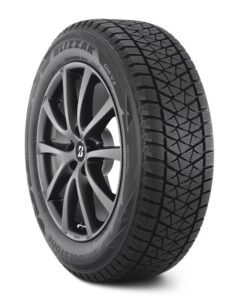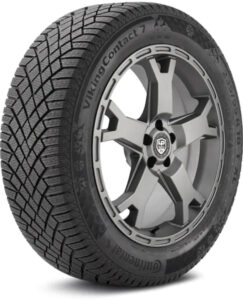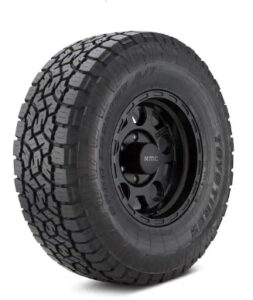When shopping for tires, you’ve probably heard the terms “all-season,” “winter” and “performance” tossed around. But don’t worry—these aren’t just adjectives that a manufacturer’s marketing department chose at random. Tires are produced in all shapes and sizes and are purpose-built for specific conditions. Winter tires are engineered specifically to handle cold climates, and they’re better at it than any other kind of tire.
The best winter tires are made of softer and more pliable compounds (the construction material of the tire is primarily rubber) and feature more aggressive tread patterns and unique sidewall designs, all of which optimize grip in snow and ice.
- Best Winter Tire for SUV: Bridgestone Blizzak DM-V2
- Best Winter Tire for Small Cars: Michelin X-ICE Snow
- Best Winter Tire for Pickup Trucks: Toyo Open Country A/T III
- Best Winter Tire for Sports Cars: Pirelli P Zero Winter
- Best Winter Tire for Crossovers: Continental VikingContact 7
- Budget-Friendly Winter Tires: General AltiMAX Arctic 12
- Best Fuel-Saving Winter Tire: Michelin Latitude X-Ice Xi2
- Heavy-Duty Winter Tires for Commercial Vehicles: Nitto Exo Grappler AWT
- Best Durable Winter Tire: Goodyear WinterCommand Ultra
Having the correct tires for your vehicle is like making sure you have the right footwear for your next adventure. You wouldn’t want to hike the hardest portions of the Adirondack Trail in a pair of beach flip-flops. The principle with tires is the same. Tires are your vehicle’s contact patch on the surface that keeps your vehicle on the road and shiny side up.
Like many other automotive commodities, the selection of winter tires is extensive and the case of getting what you pay for couldn’t be any greater. But we’ve done the homework to bring you a very short list of some of the best winter tires money can buy. All the tires on this list are classified as winter tires and rated to the tire industry’s 3PMS, or “Three-Peak Mountain Snowflake” certification.

About Best Winter Tires
When winter weather strikes, the show must go on — but with a set of dependable snow tires, you can keep the drama to a minimum. With a good set of snow tires, you can make white-knuckle winter drives a thing of the past when the forecast calls for snow.
The Best winter tires for you will vary depending on your vehicle and area, which is why we’ve divided our list of the best snow tires into several categories to cover everything from small cars and sedans to full-size trucks and SUVs.
We’ve also included some heavy-duty studded tires for the harshest winter conditions, as well as a snow-oriented performance tire in case you have mild winters with only a light dusting of snow.
In any case, our list of the finest snow tires should have a set of tires that are suitable for both your regular winter circumstances and your car.

List of the Best Winter Tires
- Michelin X-ICE Snow
- Bridgestone Blizzak DM-V2
- Bridgestone Blizzak WS90
- Continental VikingContact 7
- Firestone Winterforce 2 UV
- General AltiMAX Arctic 12
- Goodyear WinterCommand Ultra
- Toyo Open Country A/T III
- Nokian Hakkapeliitta R5
- Pirelli P Zero Winter
- Goodyear Ultra Grip Winter
- Sumitomo Ice Edge
- Michelin Latitude X-Ice Xi2
- Cooper Evolution Winter
- Nitto Exo Grappler AWT
1. Michelin X-Ice Snow
SPECIFICATIONS
MAX.LOAD: 1,929 lbs
MAX. INFLATION PRESSURE: 50 psi
TREAD DEPTH: 10.5/32″
TIRE WEIGHT: 29 lbs
RIM WIDTH RANGE: 6-8″
MEAS. RIM WIDTH: 7″
SECT. WIDTH: 9.2″
TREAD WIDTH: 7.8″
OVERALL DIAM: 28.8″
REVS. PER MILE: 723
X-Ice Snow’s substance remains flexible in cold weather settings. The product also has adequate traction. Even in heavy snow, I didn’t get stranded because of it.
Another advantage of this tire model that I like is that the braking distance is relatively short. According to my test results, the Michelin tire has a braking distance that is up to 6 feet shorter. Even when stopping forcefully during acceleration, the tire remains quiet and reliable.
The product’s daily traction is underestimated as a winter tire model.
Furthermore, the benefits of this tire model that I enjoy when traveling on snowy roads continue to work on dry roads. As a result, even in heavy rain, I drive confidently and speedily.
I should also mention the tire’s durability. The product is also one of the few winter tires with a 40,000-mile warranty. X-ICE Snow has outlasted the majority of the competition in terms of durability and tire wear warranty.
My sole criticism of this winter tire model is the noise it makes when traveling on the highway. If the French manufacturer can solve this disadvantage, the X-ICE Snow promises to be one of the best winter tires.
Good traction on ice
On dry roads, the cornering is excellent
Excellent waterproofing on slick roads
In its class, it has the shortest snow braking distance
Treadwear warranty servicing is available up to 40,000 miles
Not the most relaxing option.
2. Bridgestone Blizzak DM-V2: Best Winter Tires
SPECIFICATIONS
MAX.LOAD: 1,709 lbs
MAX. INFLATION PRESSURE: 44 psi
TREAD DEPTH: 13/32″
TIRE WEIGHT: 30 lbs
RIM WIDTH RANGE: 6-8″
MEAS. RIM WIDTH: 7″
SECT. WIDTH: 9.1″
TREAD WIDTH: 7.3″
OVERALL DIAM: 28.7″
REVS. PER MILE: 723
Driving through slush is a hazardous endeavor with sharp turns. Because collected muck will function as a considerable barrier, reducing traction.
The Bridgestone Blizzak DM-V2 is one of the winter tire styles you may rely on in this situation.
When making maneuvers on the slush, the Bridgestone tires caught me off guard. This all-terrain vehicle is so fantastic that it makes me feel like I’m driving on an ordinary, wet road. The Blizzak DM-V2 also has a natural and balanced feel when entering tight turns, which I like.
This tire model performs admirably on ice and slush on varied terrain. The product’s ice grip and braking distance are among the best in their class.
Similarly, this tire model features a long braking distance and excellent snow traction.
Bridgestone chooses to continuously improve rather than sacrifice dry grip, as many other manufacturers do for such high performance. As a result, the Blizzak DM-V2 remains safe and stable on dry roads.
In severe rain, this tire model retains a strong grip and a short braking distance. Furthermore, the product can limit vitrification, ensuring a safe driving experience.
In short, the Blizzak DM-V2 is designed to fulfill the needs of drivers who live in places with long winters. The only complaint I have with the product is that Bridgestone does not provide a treadwear warranty. When Bridgestone is a well-known brand and the Blizzak DM-V2 is an expensive model, this is a huge omission.
Slush is easily handled
In heavy rain, use caution
On dry terrain, the handling is stable
The cornering is natural and balanced
Even on tough terrain, it is quiet and pleasant
There is no warranty on treadwear
3. Bridgestone Blizzak WS90: Best Winter Tires
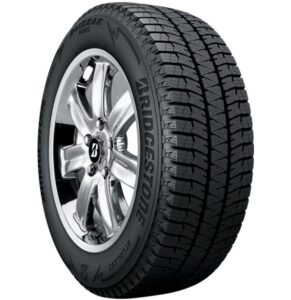
SPECIFICATIONS
MAX.LOAD: 1,709 lbs
MAX. INFLATION PRESSURE: 44 psi
TREAD DEPTH: 12/32″
TIRE WEIGHT: 29 lbs
RIM WIDTH RANGE: 6.5-8.5″
MEAS. RIM WIDTH: 7.5″
SECT. WIDTH: 9.7″
TREAD WIDTH: 8.5″
OVERALL DIAM: 28.3″
REVS. PER MILE: 736
Bridgestone proudly touted the Blizzak WS90’s introduction as “a leader in ice control.” And after a lengthy period of usage, I see why the Japanese brand is so confident.
The Multi-Cell compound increases its traction on slick ice by reducing the water layer between the spikes and the ice. As a result, even on the most slippery terrain, the Blizzak WS90 provides the best traction.
With this tire model, I can even confidently accelerate on the runway. Bridgestone’s short braking distance reduces the possibility of an ice collision.
The Blizzak WS90 thrives on snow due to its impressive performance on hard terrain such as ice.
I’m no longer caught in the snow every winter since I started using the Blizzak WS90. Furthermore, I received a rather quick input response, and the driving experience is quite comfortable.
When I used the Bridgestone Blizzak Ws90 on dry roads, the remarkable input response persisted. On this surface, the product gives even more traction than specialized summer tires.
This tire’s performance on slick roads did not disappoint me either. The Blizzak WS90 is excellent in every way, from water resistance to input response.
Not only am I pleased with its off-road capability, but I also appreciate its comfort and refinement. During use, I had no complaints about the noise or riding quality provided by the device.
Overall, the Bridgestone Blizzak WS90 is a winter tire that provides an excellent user experience. Unfortunately, the price of this device is not low, making it inaccessible to many drivers.
Excellent water resistance
Terrific on-ice control
On dry roads, this shoe has excellent grip
Outstanding braking performance on rainy roads
Expensive
4. Continental VikingContact 7
SPECIFICATIONS
MAX.LOAD: 4,080 lbs
MAX. INFLATION PRESSURE: 80 psi
TREAD DEPTH: 13.5/32″
TIRE WEIGHT: 56 lbs
RIM WIDTH RANGE: 7.5-10″
MEAS. RIM WIDTH: 8.5″
SECT. WIDTH: 11.8″
TREAD WIDTH: 9.2″
OVERALL DIAM: 34.3″
REVS. PER MILE: 607
I was initially drawn to Continental VikingContact 7 because of its specific Nordic ingredient comprising rapeseed oil. Only after using the product did I realize why Continental chose this material.
The tire composition incorporating rapeseed oil remains flexible in frigid conditions. As a result, the product can still move safely in the snow.
When the temperature is warm but the road is slick from heavy rain, the silica in the tire comes into play.
This material performs well and handles well on rainy roads. When combined with water-resistant open grooves, VikingContact 7’s stability in heavy rain is comparable to that of any all-weather tire.
This German tire frequently assisted me in accelerating on slick roads, although I did not turn the wheel. One aspect of the product’s wet performance continues to irritate me: braking distance.
Compared to winter variants, this product still has excellent braking performance. However, I expected even shorter Continental VikingContact 7 braking distances to meet the competition.
Move carefully through the snow
The excellent watertight opening groove
On slick roads, accelerate slowly
When working in severe rain, it is stable
Tire compound that is flexible in all climates
On wet roads, the braking distance is not ideal
5. Firestone Winterforce 2 UV – Best snow tires for Light Truck
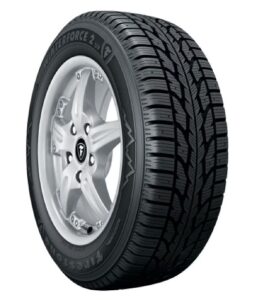
SPECIFICATIONS
MAX.LOAD: 1,764 lbs
MAX. INFLATION PRESSURE: 44 psi
TREAD DEPTH: 12/32″
TIRE WEIGHT: 27 lbs
RIM WIDTH RANGE: 6.5-8.5″
MEAS. RIM WIDTH: 7.5″
SECT. WIDTH: 9.7″
TREAD WIDTH: 7.1″
OVERALL DIAM: 28.2″
REVS. PER MILE: 740
If you need winter tires for light vehicles and vans, I highly recommend the Firestone Winterforce 2 UV.
I used the Firestone Winterforce 2 UV without any additional studs all winter. Surprisingly, the product still feels sturdy in the hand and has enough traction to avoid getting stranded in deep snow.
On the ice, despite having a difficult time without the assistance of studs, Winterforce 2 Uv performs admirably. The device still has enough traction to allow for safe acceleration and cornering.
After the severe winter was over, I drove on dry and wet roads with Firestone tires. The tire lacks response on dry roads but compensates with a safe driving experience.
In comparison to the dry road, the Winterforce 2 UV performs admirably on the wet roadway. The device has a short stopping distance, strong traction, and is waterproof. All of the benefits above have rendered a tire safe to move in the rain.
Finally, I am pleased with the tire’s durability. Winterforce 2 UV has accompanied me through two brutal winters. And the product will continue to accompany me for many winters in the future.
If the highway noise of this specific Firestone model improves, I will most likely continue to use it. Hopefully, the manufacturer will address this issue soon, making driving more comfortable.
Enduring
Short stopping distance
Cornering safely in slick circumstances
Waterproof and snow-resistant adhesive
Handle well on tape, even without studs
On the highway, there is a lot of noise
6. General AltiMAX Arctic 12 – Best Winter Tires
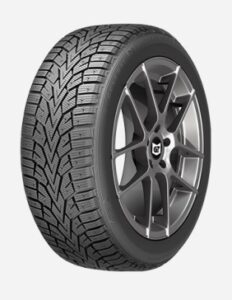
SPECIFICATIONS
MAX.LOAD: 2,149 lbs
MAX. INFLATION PRESSURE: 51 psi
TREAD DEPTH: 12/32″
TIRE WEIGHT: 34 lbs
RIM WIDTH RANGE: 6.5-8.5″
MEAS. RIM WIDTH: 7″
SECT. WIDTH: 9.4″
TREAD WIDTH: 7.8″
OVERALL DIAM: 29.1″
REVS. PER MILE: 714
One of the best features of the General AltiMAX Arctic 12 is its excellent wet handling, which outperforms all-season tires.
The large side grooves that drain swiftly to fight vitrification are most likely responsible for the General’s strength on wet roads. But, when it comes to a particular tire model, the feature that I am most concerned with is its ability to work in the winter.
Despite its low price, the Altimax Arctic 12’s performance on ice and snow is comparable to that of any high-end brand’s product.
With or without rivets, this General tire’s ability to hold the road and brake in the snow is extremely outstanding. Furthermore, even on the most difficult terrain, this tire model gives a good center feel and steering response.
Another noteworthy feature of this product is its long-lasting tires. AltiMAX Arctic 12 distributes pressure more evenly than its predecessor, which improves wear dramatically.
The only disadvantage of this device is the loud noise it makes when traveling at high speeds.
However, when additional benefits such as low cost and high durability are considered, the aforesaid drawback is quite acceptable.
The price is reasonable
Quickly drain the water
Tires wear evenly and are long-lasting
Even without studs, braking on snow is effective
On snow, several biting edges improve traction
When traveling at fast speeds, there is a lot of noise
7. Goodyear WinterCommand Ultra -Best for Acceleration On Ice
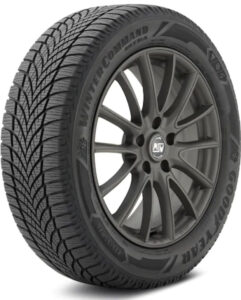
SPECIFICATIONS
Tire Size: 235/55R19
Speed Rating: H
Load Index: 105
Load Range: XL
Sidewall: Black
Uniform Tire Quality Grade: (UTQG)
Max Load (lbs): 2,039
Max Inflation Pressure: (PSI)50
Approved Rim Width (in.): 7.5 – 9.0
Measured Rim Width (in.): 8.0
Section Width (in.): 9.6
Tread Depth (in 32nds): 11
Outside Diameter (in.): 26.7
Revs Per Mile: 784
I didn’t get a chance to analyze the Goodyear Wintercommand Ultra’s performance on snow and ice during my initial test drive. However, I have a favorable opinion of the product’s smoothness and dry grip.
For a winter tire emblazoned with the three-peak mountain snowflake (3PMSF), the WinterCommand Ultra provides adequate dry traction.
The product does not create as much noise as many winter tires with excellent treads, which is unexpected.
The noise produced by Goodyear is not overpowering, and it is pretty similar to the sound produced by all-season tires. While seated in the cabin, I could still hear the tire roar, but it didn’t bother me.
One of the most unforgettable moments was while traveling long distances and a snowfall hit, putting me at risk of getting stopped on the road again.
Fortunately, WinterCommand Ultra prevented this from happening. The device provides excellent traction, allowing me to stop quickly or corner with ease. With this tire model, I can even accelerate swiftly on ice.
For months, I have not been able to test this tire type in locations with extremely difficult winters with several inches of snow.
However, based on my experience with WinterCommand Ultras, I believe it can assist you in moving safely in the harshest weather circumstances.
Before endorsing this winter tire model, I’d want to point out one of the product’s remaining flaws: the driving experience.
Cozy and peaceful
On the ice, accelerate slowly
Excellent traction on rainy roads
Handle all weather situations with ease
The driving sensation isn’t perfect
8. Toyo Open Country A/T III: Best Winter Tires
SPECIFICATIONS
MAX.LOAD: 2,403 lbs
MAX. INFLATION PRESSURE: 50 psi
TREAD DEPTH: 13.2/32″
TIRE WEIGHT: 37 lbs
RIM WIDTH RANGE: 7-9″
MEAS. RIM WIDTH: 8″
SECT. WIDTH: 10.4″
TREAD WIDTH: 8.6″
OVERALL DIAM: 30″
REVS. PER MILE: 692
Toyo, well known for its all-terrain and mud-terrain tires, is highly regarded among off-road fans for its superior traction. The Toyo Open Country AT III is a tough all-terrain tire built for light vehicles and SUVs that performs admirably in harsh winter conditions.
Its open block tread pattern excels at scratching through mud, filth, and snow. The nanobalance technology integrated into the rubber compound by the manufacturer improves fuel efficiency on the road.
The Open Country A/T III is relatively quieter than other all-terrain tires. The 3D multi-wave sipes improve wet and snow traction while decreasing uneven wear. Customers like the tough appearance, impressive off-road capabilities, wet traction, and tenacious grip on snow and ice.
The Toyo Open Country AT3 is available in three designs (LT-Metric, P/Euro-Metric, and Flotation) in 146 sizes ranging in diameter from 15 to 22 inches. The AT3 is 3-Peak Mountain Snowflake certified and has a 65,000-mile guarantee.
Outstanding traction and performance on any terrain or surface
The steering is accurate and sensitive to the natural effort
Excellent snow grip
Capable of pulling and transporting heavy loads
The sturdy appearance looks well and demonstrates its goals
The level of noise is not optimum
The Open Country AT3’s on-road performance isn’t its strongest suit
Fuel economy is worse when compared to all-season tires
Deep mud and snow can become compacted
9. Firestone Winterforce 2 UV

SPECIFICATIONS
MAX.LOAD: 1,764 lbs
MAX. INFLATION PRESSURE: 44 psi
TREAD DEPTH: 12/32″
TIRE WEIGHT: 27 lbs
RIM WIDTH RANGE: 6.5-8.5″
MEAS. RIM WIDTH: 7.5″
SECT. WIDTH: 9.7″
TREAD WIDTH: 7.1″
OVERALL DIAM: 28.2″
REVS. PER MILE: 740
The Firestone Winterforce 2 UV is intended for crossovers and minivans. Deep grooves, open shoulder slots, and wide lateral notches characterize the directional tread pattern, which is intended to provide the best grip possible. Furthermore, the high sipe-density tread design improves traction on snow and ice and resistance to hydroplaning.
The tires can be studded and are winter-ready. They have two steel belts on top of a polyester casing for a long-lasting, smooth ride. Even on dry roads, drivers report good tread life.
The Winterforce 2 UV is a new addition to the Firestone family that incorporates cutting-edge technology. Fortunately, it is less expensive than the other top-tier snow tires. Although users complain about the road noise this tire makes, the overall performance is excellent.
Snow traction is excellent
Outstanding performance in rainy and dry situations
Responsive
Dry roads are noisy
10. Bridgestone Blizzak WS90: Best Winter Tires

SPECIFICATIONS
MAX.LOAD: 1,709 lbs
MAX. INFLATION PRESSURE: 44 psi
TREAD DEPTH: 12/32″
TIRE WEIGHT: 29 lbs
RIM WIDTH RANGE: 6.5-8.5″
MEAS. RIM WIDTH: 7.5″
SECT. WIDTH: 9.7″
TREAD WIDTH: 8.5″
OVERALL DIAM: 28.3″
REVS. PER MILE: 736
The Bridgestone Blizzak WS80 performed highest for braking ability in both dry and wet winter driving situations in Tire Rack’s Winter Tires survey. This Bridgestone model came to a complete stop three to four feet earlier than the second-place model on both surfaces. The Bridgestone Blizzak WS90, its replacement, only improves on its tried-and-true performance.
Bridgestone builds its tires on a molecular level with Nano Pro-Tech®. The Bridgestone Blizzak WS90 tire, according to the manufacturer, has specifically engineered rubber molecules that link more easily with silica particles, which are essential for gripping wet roadways. This innovation, paired with the Blizzak WS90’s tread design and comfortability, elevates it to the top of the industry’s winter tire rankings.
The vehicle accelerates and brakes swiftly in the snow
Excellent ice traction
Strong traction on dry surfaces
Braking too quickly on wet terrain
Handling stability in rain
It is inconvenient to ride on a broken or lumpy surface
11. Nokian Hakkapeliitta R5

SPECIFICATIONS
Tire Width: 185
Tire Profile: 55
Wheel Diameter: 15″
Speed Rating: R
Load Index: 86
Load Range: XL
Tread Depth: 11/32″
Weight: 14.60lbs
Section Width:7.60″
Overall Diameter:23.00″
Nothing beats a Nokian when it comes to grip in harsh snow and ice situations. Nokian developed a name for itself in the market after being founded in Nokia, Finland, which has some of the world’s most dangerous winters. The snow and ice performance of its fifth-generation Hakkepeliita lineup is unrivaled. Nokian, like the Blizzak, has an in-house compound that uses a proprietary tread structure, or what they call “Arctic Grip Crystals.” It’s a wire-like beaded mesh built into the tread that behaves like extremely subtle studs, offering greater traction as the tire wears down but avoiding all of the disadvantages of studs. The sidewalls are also reinforced with a specifically designed belt that is less solid and stiff than a run-flat but just as puncture-resistant.
The top severe ice and snow tire manufacturer in the industry
Unlike any other winter tire, this compound and tread design is unique
Grip improves as you drive thanks to the unique “Arctic Grip Crystal” embedded mesh.
Prices are high, but you get what you pay for
12. Pirelli P Zero Winter
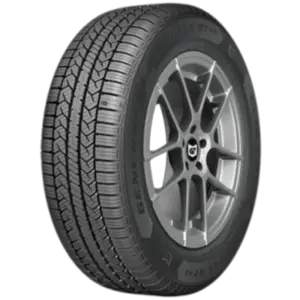
SPECIFICATIONS
Diameter: 28.7″
Width: 9.1″
Rim Range: 6-8″
Measured Rim: 7″
Tread Depth: 10/32″
Load Range: XL
Max Load: 1929 lbs
Max psi: 50
Weight: 27 lbs
Revs/Mile: 724
If you’re lucky enough to own a Ferrari GTC4Lusso or a Porsche 911 Turbo, you’ll want to outfit it with the ultimate performance rubber. That’s what the Pirelli P Zero Winter provides. Many high-performance cars choose Italy’s best tire supplier for factory-specified tires. They’re even required for racing homologation. As a result, it’s no surprise that the P Zero winters are ideal for fast cars capable of driving over ice and snow.
Any winter tire has the best road feel and feedback
Extra longevity is ensured by high treadwear
An outstanding mix of cold-weather grip and high performance
Expensive
Limited in size and often employed by high-end sports automobiles
13. Goodyear Ultra Grip Winter

SPECIFICATIONS
Diameter: 23″
Width: 7″
Rim Range: 5-6″
Measured Rim: 5″
Tread Depth: 13/32″
Load Range: SL
Max Load: 1047 lbs
Max psi: 50
Weight: 16 lbs
Revs/Mile: 910
The Goodyear Ultra Grip Winter tire is well recommended for a dependable, no-frills winter tire that can be relied on for good traction in snow, slush, and ice. These tires are suitable for passenger cars, minivans, crossovers, SUVs, and light-duty pickup trucks. They operate well in both snowy and rainy conditions.
These tires offer large tread grooves to keep snow and slush out of the tread and a directed tread pattern for enhanced traction on snow and ice. If you want even more traction on packed snow or ice, the tires can be studded with alternating rows of metal studs.
Affordable
Decent traction in all conditions
Sizes are limited
Other snow tires are more aggressive
14. Sumitomo Ice Edge

SPECIFICATIONS
MAX.LOAD: 1,709 lbs
MAX. INFLATION PRESSURE: 51 psi
TREAD DEPTH: 11/32″
TIRE WEIGHT: 28 lbs
RIM WIDTH RANGE: 6-8″
MEAS. RIM WIDTH: 7″
SECT. WIDTH: 9.2″
TREAD WIDTH: 7.4″
OVERALL DIAM: 28.7″
REVS. PER MILE: 723
The Sumitomo Ice Edge has been verified to perform optimally in snow. These tires are designed to provide grip in winter situations, whether you’re driving in a blizzard or on ice roadways. These studdable winter tires are designed to fit the majority of passenger automobiles and SUVs.
Even in subzero temperatures, the tread compound and 3D sipe technology maximize grip. The tire has a wide tread pattern that improves traction in light snow and slush. The triangle layout of the center tread blocks increases stability and aids in handling, particularly when braking.
Studdable
In chilly weather, it is sturdy and responsive
Not ideal in dense snow
15. Michelin Latitude X-Ice Xi2
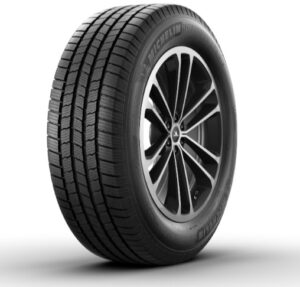
SPECIFICATIONS
MAX.LOAD: 1,929 lbs
MAX. INFLATION PRESSURE: 50 psi
TREAD DEPTH: 10.5/32″
TIRE WEIGHT: 29 lbs
RIM WIDTH RANGE: 6-8″
MEAS. RIM WIDTH: 7″
SECT. WIDTH: 9.2″
TREAD WIDTH: 7.8″
OVERALL DIAM: 28.8″
REVS. PER MILE: 723
According to our study, the Michelin Latitude X-Ice Xi2 snow tire is the finest in its class overall. It works particularly well on compacted snow and ice, giving excellent grip in cold, damp weather. This tire’s users describe a quiet and comfortable ride on a variety of road surfaces and in a variety of weather conditions.
Check out Michelin’s top-of-the-line winter tire for optimum confidence on snow and ice. The Latitude X-Ice XI2 is available in sizes to fit light trucks and SUVs searching for a no-compromise winter tire. The Latitude X-Ice SNOW on all four sides will assist passenger automobiles and crossovers.
Michelin’s directional snow tire is made with a proprietary Flex-Ice silica rubber compound that keeps it flexible in extreme cold and above-freezing temperatures. The deep grooves and massive tread blocks drain water and slush outward, while the full-depth Cross Z sipes claw into the snow and ice.
The tread blocks also tighten the shoulder blocks, allowing this snow tire’s dry road-handling qualities to be on par with all-season tires.
The Michelin Latitude X-ICE is Green X certified, which means it has reduced rolling resistance and so saves fuel. Longer tread life and an environmentally responsible manufacturing process are both part of the certification.
The manufacturer is sure that these tires will outlast their competitors for an additional cold season. It backs up that promise with a 6-year, 40,000-mile limited warranty.
Excellent traction on ice and snow
Meets severe snow service requirements
Effective siping
Reduced traction and slowness in deep slush
Not as gripping as studded tires
Not intended for deep snow that lasts all season
16. Cooper Evolution Winter

SPECIFICATIONS
Diameter: 23.11″
Width: 6.9″
Rim Range: 5-6″
Measured Rim: 5″
Tread Depth: 12/32″
Load Range: SL
Max Load: 1047 lbs
Max psi: 44
Weight: 17 lbs
Revs/Mile: 899
This tough winter tire is suitable for vehicles, crossovers, and SUVs. It performs admirably in heavy snow and other harsh factors that winter may throw at you. The tires can also be studded for better traction on ice. They are weatherproof and come with a normally limited guarantee.
According to reviewers, this winter tire delivers outstanding traction in deep snow and on icy roads. The Evolution Winter features a directed tread design for improved braking and acceleration on wet roads.
The wide, stiff tread blocks give stability for improved traction on ice or in deep snow. Having said that, the Cooper Evolution Winter is intended to be used exclusively in very cold circumstances — and is definitely overkill for moderate winter seasons or mostly dry roads.
The Discoverer Evolution Winter is available in 67 sizes for wheels with diameters ranging from 14 to 20 inches.
Studdable
Service for Severe Snow Rated
Various sizes are available
The aggressive tread pattern is not suitable for dry roads in hot temperatures
17. Nitto EXO Grappler AWT

SPECIFICATIONS
Diameter: 32.05″
Width: 9.3″
Rim Range: 6-7.5″
Measured Rim: 6.5″
Tread Depth: 18.3/32″
Load Range: E
Max Load: 3085/2835 lbs
Max psi: 80
Weight: 51.3 lbs
Revs/Mile: 649
The Nitto EXO Grappler AWT is a winter-rated tire that can manage all of the above — and more — if you’re searching for a do-it-all, off-road-ready rubber that can also handle a winter blizzard. The all-weather compound is stud-drilled and has a tough three-ply sidewall for enhanced durability on rocky roads.
The tread pattern is intended to give traction both off the pavement and on snow or ice. The lateral grooves are responsible for removing water, snow, and slush from the tire. Nitto even has a variable pitch tread block design to help reduce road noise on the highway.
It’s not often that a multitasker does everything so well, but the EXO Grappler AWT is ideal for rough winter driving and adventurous off-roading.
Studdable
Off-road ability
Excellent traction in heavy snow and ice
Expensive

What Exactly Is a Winter Tire?
Winter tires, sometimes known as snow tires, are intended to grip and move safely in snow, ice, and other tough winter conditions. They’re made using a variety of rubber compounds to ensure optimal flexibility even in subzero temperatures.
A three-peak mountain snowflake (3PMSF) insignia may appear on winter tires. This, according to Tire Rack, “indicates that the tire meets the required performance criteria in snow testing to be considered severe snow service-rated.” However, according to Tire Rack, 3PMSF testing only covers “a tire’s acceleration traction on medium-packed snow” and does not take into account the tire’s ability to brake and turn in winter circumstances.
Thanks to recent technological improvements, winter tires can effortlessly shift from wet to dry conditions. Winter tires, on the other hand, should not be used throughout the year. Install winter tires in late November and remove them in February or March.

Things to consider while selecting winter tires
After much searching and careful consideration, I’d like to share some of my findings. Hopefully, the evaluation criteria listed below will assist you in selecting the best product.
Tire dimensions
The tire size must be appropriate for the vehicle and consistent. Look at the sidewall to read the sizing specs. The first four figures indicate tire type and tread width, while the second two indicate top hold ratio and tread width. Finally, the numeral following the R represents the tire’s diameter.
Braking and handling
The two most critical elements for safe driving on icy terrain are handling and braking. As a result, your product must have dependable braking performance as well as the ability to withstand low temperatures.
Choose items that have ingredients that are flexible even when the temperature goes below 7 degrees Celsius. Furthermore, when it comes to braking performance, the shorter the stopping distance, the more important it is to consider it.
Budget
Many factors influence a product’s pricing, including materials, modern technology, and brand. To make the best decision, examine key aspects that must be present in the tire while avoiding unneeded features.
Also, remember to compare prices and take advantage of deals to purchase the finest quality products at the lowest prices.
Consider the road’s surface
Everyone’s driving requirements are unique. If you usually drive on the street, for example, you won’t want many advanced features such as greater terrain handling or shorter stopping distances.
If you are feeling daring, you could invest in high-quality winter tires.

Winter Weather in Your Area
Consider where you live first. You may be able to use all-season or all-terrain tires in places with mild winters or those that only receive a few light snowfalls per winter. If you frequently drive in snow or ice storms, you could certainly benefit from a set of snow tires.
Snow Tires vs. All-Season Tires
Many people believe that if you have all-season or all-terrain tires, you don’t need snow tires. All-season tires are intended for year-round use, while all-terrain tires perform well in conditions such as mud and rain. Snow tires are designed to provide optimum traction in snowy and icy conditions.
In the winter, snow tires work well. Snow tires have a hydrophilic rubber compound, whereas all-season tires have a harder rubber compound. All-season tires with tougher rubber perform better on hot pavement. In chilly winter temperatures, the softer rubber of snow tires will be more malleable.
Another consideration is tread design. Snow tires have deeper grooves and distinct tread patterns to prevent slush and ice from accumulating in the tread. Many snow tires can also be outfitted with metal studs — studded snow tires are the most winter-ready tires you can put on your car.
Brand & Price
One last thing to think about is how much money you want to spend. Many snow tires are priced similarly, so if you’re on a tight budget, you can prioritize the lower-cost ones.
Most well-known tire manufacturers provide at least one high-quality snow tire that should function well in winter circumstances. If you have a favorite tire brand, chances are they also make a snow tire that you may buy for your car this winter.
Methodology
We only evaluate top-rated tire manufacturers with decades of experience in this category when determining the best winter tires. Despite their greater treadwear and lack of a treadwear warranty, winter tires must outperform all-season tires on snow and ice. Price is less of an issue because these are cold-weather tires that cannot be utilized on a car year-round in milder temperatures. Having said that, we compared pricing using a basic tire size seen on the majority of new crossovers, SUVs, and automobiles.

Frequently Asked Questions (FAQs)
Is it true that decent winter tires make a difference?
Winter tires are important, especially while driving on ice. Winter tires can handle rough terrain better than summer tires, such as hills and slick surfaces.
What is the lifespan of winter tires?
Winter tires, contrary to popular opinion, are quite durable. Many models of high-quality winter tires with a lifespan of 6 to 10 seasons have been identified.
What are the drawbacks of winter tires?
The soft rubber of winter tires is prone to punctures and does not handle as flexibly as all-season tires.
Can I only put two winter tires on the front?
Instead of only fitting the front axle, you should replace all of your vehicle’s tires with winter tires. Installing specialty tires on the front wheels can put you at risk of poor handling and loss of rear wheel grip.
When should you rotate your snow tires?
The recommended tire rotation interval is every 5,000-7,000 miles or every 6 months.
Is it worthwhile to invest in winter tires?
Unless you live at a lower height where snow and ice seldom fall, the answer is yes. Even if you just travel to higher elevations for the holidays or ski a few times a year, it’s a good idea to have a set of four winter tires put on a set of wheels and stored so you can swap them out without any cost or difficulty.
Is it necessary to have winter tires on all four wheels?
Definitely. Having snow tires exclusively on the front or back will result in more erratic handling in all situations, resulting in unexpected skids and less stopping power on snow and ice.
Can winter tires be used all year?
They can, but you’d be wasting a precious (and expensive) resource. During warm-weather driving, you don’t need deeper treads or biting edges, and the softer compound of the tires will lead them to wear out faster. Furthermore, the performance of winter tires on dry or wet roads in high weather is not nearly as good as that of an all-season or summer tire.
What exactly is a winter tire?
- Winter tires are made to operate well in temperatures below 7 degrees Celsius.
- Even in low temperatures, their soft rubber compound remains malleable, providing a greater grip on snow and ice.
- Sipes form biting edges that hold snow.
- Snow tires include large tread grooves with sharp-angled tread blocks to press into the snow for maximum traction.
- On the sidewall of certified winter tires is the 3-Peak Mountain Snowflake insignia. It should be noted that the M + S symbol does not signify that a tire is a certified winter tire.
- Increase your vehicle’s handling and traction by installing winter tires on all four wheels.
Is it acceptable to purchase secondhand snow tires?
If you’re on a tight budget, used snow tires may be a better option. However, be certain that the snow tires have been rarely used, are no more than a year or two old, and do not have excessive wear.
Check the tread depth to ensure that the tire has adequate life left in it. A new tire typically has 11/32 inch tread depth. When purchasing a secondhand tire, look for something in the 7-10/32 range or higher.
Also, make sure the tires aren’t more than a few years old (and certainly no more than 6 years from the date of manufacturing). Rubber degrades (dry rots) over time, diminishing tire dependability and capability in unfavorable weather conditions significantly.
Are chains preferable to snow tires?
Chains are probably not the way to go if you plan to travel on the highway in snowy weather. Chains are useful in snowy and slippery circumstances. They are, however, best suited for slower-speed mountain driving and must be put on and removed at the side of the road.
Snow tires, on the other hand, are designed to drive not just on snow and ice, but also at high speeds on dry roads. Chains are not a replacement for snow tires, although they can be useful to have on hand in an emergency.
What are the best ice tires?
On the ice, studded tires perform best. If your locality prohibits the use of studded tires, a dedicated snow tire rated 3-Peak Mountain Snowflake is the next best option.
What is the distinction between studded snow tires and studless snow tires?
Consider your driving patterns while selecting the type of snow tire you require. Studless tires perform admirably in slush and compacted snow. They have wide and deep grooves that provide excellent traction.
Studded tires, on the other hand, provide even more traction on the ice. For increased traction, the metal studs will grasp onto slick surfaces. One disadvantage of studded tires is that they can be fairly noisy on dry surfaces.
When should you update your winter tires?
Winter tires with the 3-Peak Mountain Snowflake insignia on the sidewall should have a minimum tread depth of 4 mm, according to tire manufacturers.
What precisely is a high-performance winter tire?
In cold weather, the design of a high-performance winter tire must compete with the power of high-performance automobiles. As a result, high-performance snow tires maximize grip and braking performance and are a good choice for drivers who do not have a backup vehicle for winter travel.
Furthermore, when used on AWD performance vehicles such as the Ford Focus RS, Subaru WRX STi, Porsche Cayenne Turbo, or Audi RS, these tires can provide more confidence in wintery conditions.
Is it safe to drive all year on winter tires?
Winter tires are intended for use in temperatures below 45 degrees Fahrenheit (7 degrees Celsius). As a result, even in cold weather, the soft rubber compound remains malleable, providing a superior grip on snow and ice. The soft substance degrades rapidly on hard and dry surfaces and does not function well in warmer weather like a real all-season tire.
Are snow tires worthwhile for AWD or 4WD vehicles?
The answer is a resounding “yes,” because a winter tire improves grip, handling, and braking on any vehicle. AWD and 4WD cars excel at dispersing power to the wheels with the least traction. Tires made specifically for winter circumstances will perform admirably in harsh winter conditions. Whatever drive system is in use, all traction is provided by the tires and their capabilities.
How can I figure out what size tires I have?
The dimensions are printed on the sidewall of the tire. If you can’t find the numbers on the sidewall, contact the manufacturer to receive the correct measurements for your vehicle’s year, make, and model.

Conclusion
I have picked the top eight best winter tires for you, along with extensive reviews. As you can see, each name has distinct advantages.
With its 40,000-mile warranty, the Michelin X-ICE Snow stands out the most. In addition, the Bridgestone Blizzak DM V2 is an outstanding alternative with excellent durability.
Whatever you decide, the list of the best winter tires above contains useful recommendations. I hope you discover the proper ice and snow product soon!

